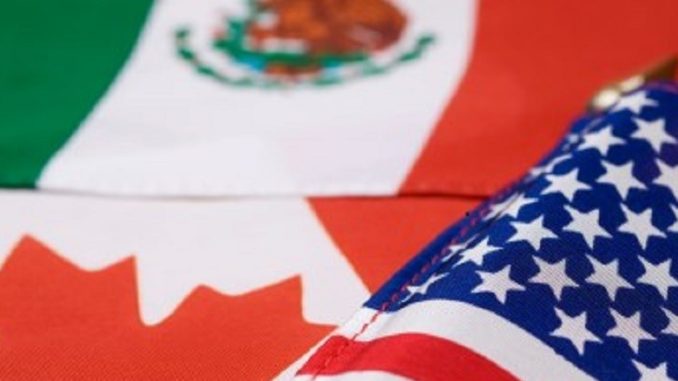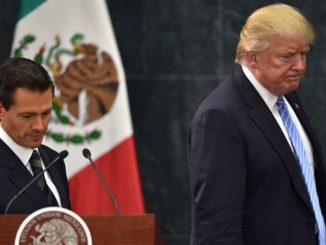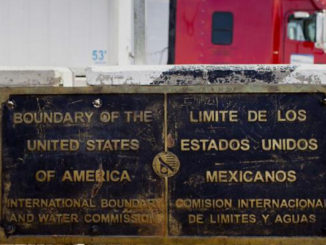
by Julian Aguilar
Two decades after a pact initiated here created the world’s largest free trade area, economists are calling the North American Free Trade Agreement a resounding success, crediting it for fueling unprecedented trade and creating millions of jobs in the United States.
The agreement between the U.S., Mexico and Canada, ratified 19 years ago Saturday, also made two of Texas’ land ports among the country’s busiest and delivered a multitrillion-dollar cumulative gross domestic product for its member countries.
But unions and consumer-advocacy groups say NAFTA has had negative effects in Mexico and the U.S. They say that resulting outsourcing and lower wages have hurt the United States’ domestic economy and that Mexico’s rural industries have destabilized.
As economists look to build on NAFTA’s momentum to improve trade relations between member nations, critics say they should look to past failures to avoid similar mistakes in the future.
NAFTA, which was enacted in 1994, eliminated existing tariffs on more than half of the exports from Mexico to the U.S., and gradually phased out remaining tariffs between all member countries.
The pact has benefited all three members. In 2010, the U.S. had $918 billion in two-way trade with Canada and Mexico, according to U.S. Trade Rep. Ron Kirk’s office.
Economists say that progress has come despite enhanced global security measures following the Sept. 11 attacks and an eruption of drug-related violence in Mexico. During a recent symposium here, economists and policymakers celebrated NAFTA’s success and brainstormed on how build on it and bolster economic output. The symposium concluded with a clear message: The future is wide open.
“We must continue to build upon NAFTA and think more as a region in order to be more competitive globally,” said Gerónimo Gutiérrez, the managing director of the North American Development Bank, which was created by the governments of Mexico and the U.S. after NAFTA’s inception and helps finance and develop infrastructure projects on the border.
But opponents of trade pacts say that NAFTA has resulted in a loss of manufacturing and shipping jobs in the U.S. and in less oversight of production. They say that NAFTA has also caused the displacement of Mexican agricultural workers into other sectors, or forced them to immigrate illegally to the United States.
“There have been huge disparities in the number of people entering the workforce and the number of jobs available,” said Timothy A. Wise, the policy research director at the Global Development and Environment Institute at Tufts University. “That resulted in the huge migration problem despite the increased enforcement.”
Supporters say NAFTA was not conceived to solve domestic problems for any member country. Instead, they say, the growth in the nations’ GDPs speaks to the pact’s positive effects. They include the creation of 6 million jobs in the U.S. as a result of NAFTA policies, more than $500 billion in goods and services traded between the U.S. and Mexico, and the ports of Laredo and El Paso being among the United States’ busiest.
Through September, about $172.5 billion in trade with Mexico passed through the Laredo port and about $65 billion through El Paso, according to U.S. census data analyzed by WorldCity, which tracks global trade patterns. Canada remains the country’s top partner, with $462.3 billion in trade during the same time frame, ahead of China, which is at $389.7 billion and Mexico, with $369.5 billion.
“I don’t think that NAFTA was created to alleviate every single social problem in Mexico. It could not, and it has not,” Gutiérrez said. “I think that Mexico would be worse off if it wasn’t for NAFTA today.”
Public Citizen, a nonprofit advocacy group with offices in Washington and Austin, cites U.S. Department of Labor data to support what it says is a negative impact on the American workforce because of rising imports or off shoring production.
In Texas alone, Public Citizen reported, there have been almost 2,500 companies whose workers or union affiliates have filed petitions with the department for training or temporary assistance under its Trade Adjustment Assistance program.
Wise said that although NAFTA made Mexico a manufacturing giant, the pact provides examples of what countries with emerging economies should avoid. Free trade policies, commonly referred to in Mexico as neoliberalism, should be scrutinized less for the tariffs they eliminate and more for how they work as development strategies.
“It was a striking and dramatic failure compared to other countries that did not follow such paths,” he said. Wise acknowledged Mexico’s increase in manufacturing jobs, but he said they were not at the level needed to account for losses in other industries, like grain production. “Foreign investment quadrupled, trade overall tripled, so that’s a measure of success,” he said. “What it didn’t produce is jobs and development.”
The end result is that Mexico’s growth rates were lower than other emerging economies that were in similar stages of development, he said. A key reason is that while foreign investment surged, domestic investment in Mexico dipped. “When everybody touts the benefits of foreign investment coming in, they discount the fact that domestic investment was displaced,” Wise said. “Investment in the economy was well below the levels that were needed to stimulate dynamic growth. In China they are investing 35 percent dynamic growth, and economists say you need 25 percent or more, Mexico is at 19 percent.”
Robert Pastor, the director at the Center for North American Studies at American University, said job losses and gains under NAFTA can be credited to a universal element in global commerce: competition.
“NAFTA or globalization increases competition which, by definition, has winners and losers,” he said. “The people who lose are those who are not very well educated. This is true, not just because of trade, but because of automation and technological change and of a lot of structural change in the economy.”
Pastor said that despite dire predictions, the largest influx of growth in jobs in the U.S. occurred after the pact’s installation.
“The period of greatest growth in trade among the NAFTA countries coincided with the period of the largest growth in employment, of jobs in the United States, 23 or 24 million jobs,” he said. “Now, I wouldn’t credit NAFTA for those creation of jobs, but you certainly can’t say the impact was a loss of jobs.”
Pastor said the focus for member nations should expand. “I think we should shift our vision away from NAFTA,” he said, “and accept that it’s complete and focus on the future.” He said the need was to figure out how to get to a seamless market that would eliminate remaining tariffs.
This report was originally published on the Texas Tribune



